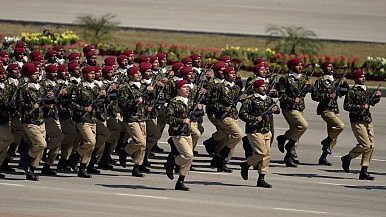By Kunwar Khuldune Shahid
 The fall of its de facto Syrian capital Raqqa last month signaled the death of the Islamic State (ISIS) in the Middle East. On Friday, Syrian troops retook Deir ez-Zor, the last major city with an ISIS presence, just as Iraqi forces took over the crossing in al-Qaim, near the group’s final urban stronghold.
The fall of its de facto Syrian capital Raqqa last month signaled the death of the Islamic State (ISIS) in the Middle East. On Friday, Syrian troops retook Deir ez-Zor, the last major city with an ISIS presence, just as Iraqi forces took over the crossing in al-Qaim, near the group’s final urban stronghold.
As the group flees the Middle East, it has two obvious destinations: Central and South Asia. Central Asia has accounted for upwards of 5,000 ISIS troops, and South Asia has 40 percent of the global Muslim population – and indeed an entire dedicated ISIS faction – making the region the natural destination for fleeing militants.
The greatest lifeline for ISIS might come from the jihadists that form the large chunk of ISIS Khorasan: the leaderless factions of the Pakistani Taliban.Enjoying this article? Click here to subscribe for full access. Just $5 a month.
On October 19, a statement attributed to the Jamaat-ul-Ahrar (JA), a Taliban faction that has pledged allegiance to ISIS, said that the group’s Umar Khalid Khorasani has succumbed to injuries following a U.S. drone strike. A day later the group’s Telegram account denied the claims. Since there weren’t any images, audio or video footage in the denial, this appears to be a classic Taliban tactic of denying a leader’s demise long after they’ve been killed.
This is how Mullah Omar was “kept alive” for over two years and how Tehrik-e-Taliban Pakistan (TTP) chief Fazlullah might still be posthumously leading his group – another Taliban faction only confirmed their leader’s death from last year after news broke of Khorasani being killed.
Therefore, there’s more than a fair chance that both the TTP and JA might be leaderless – and aimless – as things stand, and perhaps as desperate for some breathing space as their fellow jihadists in the Levant.
JA in particular has collaborated with ISIS – at least on paper – on many terror attacks over the past two and a half years. This year’s deadliest attack in Pakistan, when a Sufi shrine was bombed in Sehwan leading 88 dead, was jointly claimed by ISIS and Jamaat-ul-Ahrar, with the Khorasan faction taking responsibility for August’s attack on the military truck in Quetta.
From ISIS Khorasan’s formal announcement in January 2015, which had been preceded by ISIS graffiti and literature popping up across Pakistan, jihadist factions as diverse as Lashkar-e-Jhangvi (LeJ) – which is dedicated primarily to the extermination of the Shia – and Jamaat-ud-Dawa – which claims to focus on Kashmir jihad – have overlapped with ISIS in Pakistan.
Furthermore, considering that the Pakistan is now formalizing the mainstreaming of many of these jihadists by making them bona fide political players in the country, and the fact that the state continues to encourage jihadamong sections of the population, the lure of the ISIS caliphate alone can sustain the group in the country, even with limited operational presence.
The UN Humanitarian Response Plan Mid-Year Review reports the doubling of “attacks attributable to the Islamic State of Khorasan (from 128 to 237)” in Afghanistan, with the group expanding its presence to seven provinces in the first half of this year. This rise has corresponded with the group’s depletion of resources in Iraq and Syria.
Even so, while Islamic State’s functional presence remains mostly in Afghanistan, where they are rivaled for supremacy by the Afghan Taliban – despite recent ISIS ascendancy – it is Pakistan where a bulging vacuum for a jihadist umbrella remains.
What the Pakistani state will do if and when ISIS and the Taliban regroup in unison, with some of their allies perhaps sitting in the Parliament, remains to be seen.
No comments:
Post a Comment